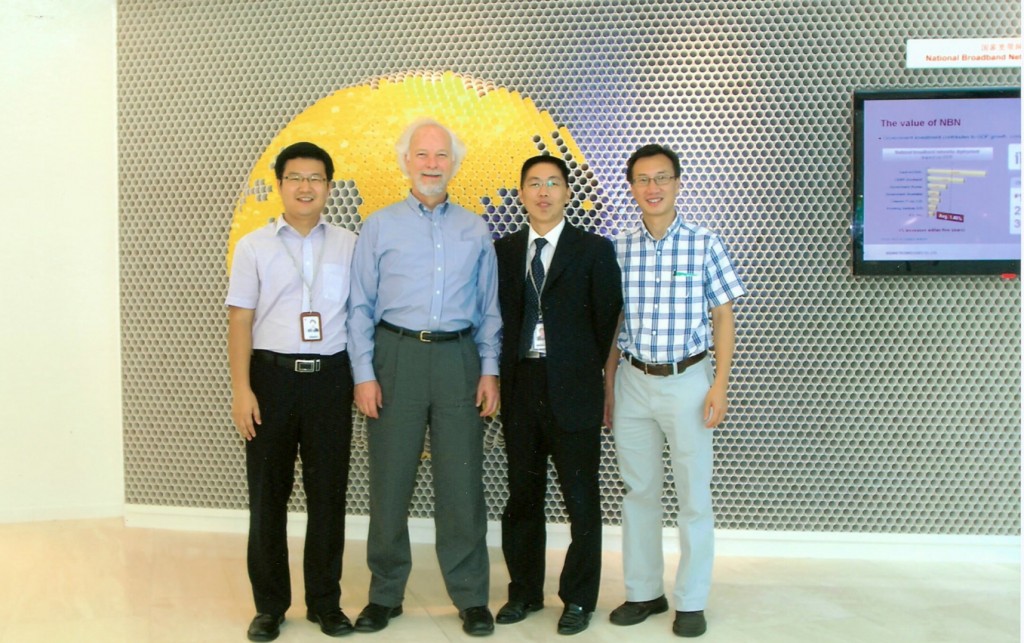The amount of energy consumed by data centers is increasing rapidly around the world, and China is no exception. With its growing information technology and telecom industries and its emerging status as a supercomputer power, China continues to expand its data center capacity. In an effort to help reduce carbon emissions, the U.S. Department of Energy’s Lawrence Berkeley National Laboratory, a world leader in high-performance buildings, has started working with China to improve the energy performance of its data centers.
The project is jointly run by Dale Sartor, leader of the Building Technology’s Applications Team (A-Team), which specializes in the energy efficiency of high-tech facilities, and Bo Shen of the China Energy Group. The Berkeley Lab scientists will work with the China Institute of Electronics and the China Electronics Standardization Institute to share best practices, case studies and other material to help China develop standards and training programs for its industry. “As in other countries, there’s huge variation in the data centers in China, but there is a lot of room for improvement,” Sartor said, after two visits to China in four months.

Berkeley Lab scientists Dale Sartor (second from left) and Bo Shen (far right) visit Huawei's data center in China.
China is eager to participate in initiatives to boost its energy efficiency, partly because of a central government mandate to reduce the economy’s energy intensity. And for its data centers, there are cost incentives that are often even stronger than those for data centers in other countries. “The overall cost of both utility-supplied and onsite-generated power is expensive, so therefore, it can be even more cost-effective for China than here to take energy efficiency actions,” Sartor said.
Moreover, it is an opportune time to implement standards, given that China is still relatively early in the development curve and may be on the brink of explosive growth. “It’s important because one of our interests is targeting an industry that’s in its youth so it can leapfrog, and we can make sure they do it right the first time,” Sartor said. “China is looking at India and saying, ‘we want to be knowledge workers as well.’ It’s eying the IT [information technology] industry as a growth area, not just to support their manufacturing, but they see the kinds of services India is providing as something their population can profit from. So the IT industry growth is potentially huge.”
In the United States and other countries, data centers have proliferated due largely to skyrocketing demands for communications, data storage, data processing and the digitization of vast sectors of the economy. A 2007 report by the Environmental Protection Agency found that the energy used by data centers—including the servers as well as the infrastructure to power and cool them—had doubled in the previous five years. Data centers accounted for 1.5 percent of total U.S. electricity consumption in 2006 and were on track to double by 2011.
In China, it appears the telecommunications rather than the IT industry dominates the data center market. China is also moving aggressively into the supercomputer market—it now has two of the top 10 fastest supercomputers in the world and 42 of the top 500, ranking second behind the United States (with 275).
Another difference is that most data centers in China tend to be government owned or controlled. “It’s a little harder to use the entrepreneurial approach, but once you convince the government to make the changes, since it’s centrally controlled, they can make the changes quicker,” Sartor said. “If you get them to change, big changes can occur rapidly.”
A common measure of data center efficiency is the power utilization effectiveness (PUE), which is the ratio of the entire data center’s energy usage to the energy going just to the servers and other IT equipment. A typical U.S. data center has a PUE of 2, meaning that for every kilowatt of power going to the computers, another kilowatt goes to the cooling, electrical system losses, lighting and other building functions. But the performance varies widely in the U.S., with the very best ones having PUEs as low as 1.1 and some inefficient ones as high as 4 or more.
Sartor says it is not difficult to make data centers more efficient and attain a PUE of 2 or lower. Sometimes it’s simply a matter of turning computers around, or plugging an empty slot in a rack with a blanking plate so that hot air doesn’t recirculate. “The level of engineering that goes into the infrastructure around a data center is so far behind what’s in the rack it’s not even funny,” he said. “Throughout the world, lack of knowledge of how to implement energy-efficiency measures is what’s holding industry back, not economics.”
Turning computers around so that they all face the same direction and the hot exhaust goes out the back creates hot and cold aisles; this is a basic element of energy efficient data centers that can be achieved with little additional cost. Furthermore, the “cold aisles” do not need to be cold. Computers can be cooled at 80 degrees Fahrenheit or warmer. “Our goal is to reduce or eliminate the need for mechanical (compressor) cooling,” Sartor says.
Berkeley Lab also hopes to work with China to implement more advanced concepts, such as warm-water liquid cooling and DC power, through its partner agency.
Lawrence Berkeley National Laboratory is a U.S. Department of Energy (DOE) national laboratory managed by the University of California for the DOE Office of Science. Berkeley Lab provides solutions to the world’s most urgent scientific challenges including sustainable energy, climate change, human health, and a better understanding of matter and force in the universe. It is a world leader in improving our lives through team science, advanced computing, and innovative technology. Visit our website.
Additional information:
- Department of Energy: Data Centers
- Berkeley Lab: Data Centers
- Berkeley Lab’s China Energy Group